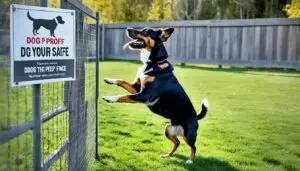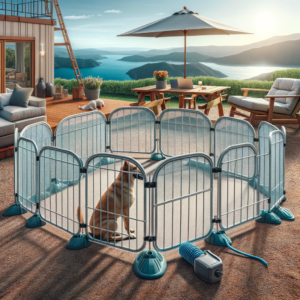GUIDES
Types of Dog Fences
When it comes to keeping our beloved furry companions safe, choosing the right dog fence is crucial. Various options are available, catering to different needs and preferences.
Outdoor Dog Fences and Gates
One popular choice is outdoor dog fences and gates. These provide a physical barrier around your property to keep dogs from wandering off. Available in wood, vinyl, or metal, these fences combine durability with aesthetics. They can be customized to match the design of your home, adding both functionality and curb appeal.
Chain Link Dog Fences
Chain link fences are a durable and cost-effective option. Made from galvanized steel wire mesh, they provide a secure barrier that dogs cannot easily break through or chew. Chain link fences are low-maintenance, long-lasting, and can be customized with different heights and gate options to suit various needs. They are particularly suitable for large yards and active dogs.
Above Ground Dog Fences
Another option is above ground dog fences. Easy to install, these fences require no digging. They’re versatile, movable, and ideal for renters needing temporary containment. When selecting above ground dog fences, choose sturdy, tall options to prevent dogs from jumping over. Some breeds are prone to jumping due to their energy levels, making the choice of height and material essential for their safety.
Portable Dog Fences
Portable dog fences, also known as exercise pens, offer flexibility and convenience. These temporary enclosures, typically made of interlocking metal wire panels, can be easily set up and taken down. They are perfect for camping, traveling with pets, or creating a safe play area in the yard. Many are designed for easy assembly without tools, making them an ideal choice for temporary setups. Additionally, portable dog fences are lightweight and compact, making them easy to transport.
Electric Fences for Dogs
Electric fences are an effective solution for keeping dogs safe within property boundaries. These systems use a buried wire or wireless signals to create an invisible boundary, training dogs with audible warnings and mild static corrections. They offer a modern alternative to traditional fences and can be less intrusive on your property’s appearance.
Types of Electric Fences
Wireless/Radio Fence: Utilizes a transmitter to create a circular boundary. The dog’s receiver collar emits a warning tone or a static correction if they approach the edge. This type is easy to install and portable, making it suitable for multiple locations.
In-Ground Wired Fence: Involves a wire buried around the property’s perimeter. The dog’s collar delivers a correction upon crossing the boundary. This type offers more customization in terms of boundary shape and size.
Electric fences are more affordable than physical fencing but require proper training. They rely on deterring the dog through discomfort rather than physical barriers, a method debated for its humane implications.
Installation Guides
Choosing the right fence involves considering various factors to ensure your dog’s safety. Each type of fence, from traditional wooden fences to modern electric systems, has specific installation requirements. For instance, wooden and chain link fences need stable posts and proper alignment, while electric fences require careful calibration of the transmitter and receiver.
Dog Fence Safety
The safety of our canine friends is paramount. When choosing a fence, consider the materials used and ensure they offer the durability and security needed to keep your pet safe. Regular inspections for wear or damage are essential, and training your dog to respect fence boundaries can significantly reduce the risk of escape attempts.
Conclusion
Pet owners have many options for dog fencing, each with its advantages and considerations. From traditional wooden fences to portable and electric options, understanding these helps in choosing the most suitable fence for your dog’s safety. Proper installation, regular maintenance, and appropriate training are critical to ensuring the effectiveness of these containment solutions. With the right planning and consideration, dog fences can provide security and freedom for pets while offering peace of mind to their owners.
- Chain link fences are durable, secure, and cost-effective. They offer visibility, are low-maintenance, and can be customized with different heights and gate options to meet specific needs.
- Portable dog fences, or exercise pens, consist of interlocking metal wire panels that form a contained space. They are easy to set up and take down, making them ideal for temporary containment like camping or traveling with pets.
- Electric fences can be safe when used correctly, but they require proper training to ensure the dog understands the boundaries. The safety can vary depending on the dog’s temperament and breed; consulting a veterinarian or a training expert is recommended before installation.
- Yes, above ground dog fences are designed to be versatile and portable. They can be easily moved and reassembled in different locations, making them ideal for renters or homeowners who may need to change the containment area.
- Consider the material, height, and durability of the fence to ensure it meets your dog’s needs. Check local zoning laws regarding fence installation. Ensure the fence is secure enough to prevent your dog from jumping over or digging under it.
- Evaluate your property’s layout, your dog’s size, and behavior patterns. Consider whether visibility, portability, or aesthetics are your priority. Additionally, think about whether you prefer a physical barrier or an invisible one like an electric fence.








